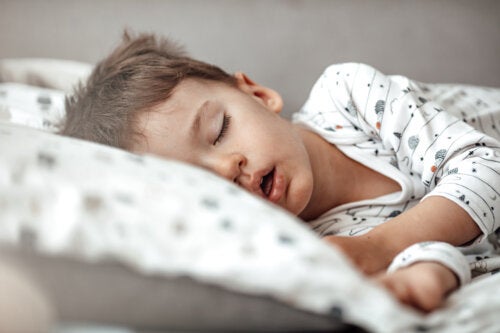Infant Somniloquy: When Your Child Talks in Their Sleep


Written and verified by the psychologist Elena Sanz Martín
Does your child talk in their sleep? Observing this phenomenon can be disconcerting for parents, especially when the vocalizations are accompanied by screaming or crying. However, it’s a very common phenomenon in children that, in principle, has no reason to alarm you. It’s known as infant somniloquy, and here, we’ll tell you everything you should know about it.
As we were saying, there are many families that experience infant somniloquy with their little ones. In fact, it’s estimated that between 8 and 14.2% of school-age children have this behavior. It’s a harmless sleep disorder that normally doesn’t affect the child. But when should we be concerned? And how can we deal with it? We’ll explain it to you.

What is infantile somniloquy?
To understand what somniloquy is, we must first talk about parasomnias. These are behaviors that appear in different phases of sleep, that are unconscious, and that, generally, aren’t remembered. Among them, we find some as common as nightmares, night terrors, or bruxism, and others that are less well-known, such as somniloquy.
In the case of the latter, we’re referring to episodes of short duration in which the child emits more or less complex vocalizations, without having the will to do so and without remembering anything about it afterward. The content of these may range from small unintelligible sounds to words or even monologues and conversations. In addition, soft whispering or intense high-pitched verbalizations may be observed.
Sometimes, the verbal phenomenon is accompanied by emotional expressions, such as crying, screaming, or laughing. In addition, the child may appear confused during the episode. However, once the episode is over, the child continues to sleep without problems and without being aware of what happened.
Although infantile somniloquy can occur at any time during sleep, it’s most common during the deep sleep phases and during REM (rapid eye movement) sleep. In addition, it usually occurs during the first half of the night or the period when the child’s napping.
Find out more: Children and Sleep: Common Problems and Solutions
Why does infant somniloquy occur?
Somniloquy is usually due to a transient awakening from REM sleep. But it’s also possible for there to be a mismatch in the activation/inhibition of certain areas of the brain.
For example, as reported in an Elsevier Connect article, during REM sleep, muscle tone throughout the body is very depressed because there’s a strong inhibition of the spinal muscle control areas. This causes us to remain immobile, even when having very vivid dreams.
It may happen, then, that the brain areas that control the activity of the oral-facial muscles remain active. Therefore, as this atypical activation of psycholinguistic circuits takes place during sleep, the child speaks in their sleep.
But why does this happen in some people and not in others? Well, no exact cause has been found for the occurrence of infantile somniloquy. However, according to the researchers at Sleep Disorders Medicine, there seem to be certain associated factors:
- There may be a genetic component that leads to this phenomenon occurring in different generations of the same family.
- It’s associated with the presence of other parasomnias, such as sleepwalking or nightmares.
- It occurs more frequently in times of anxiety, stress, or major changes in the child’s life.
- It appears more frequently in febrile states.
Does infant somniloquy have consequences?
As we said, this phenomenon is very frequent and generally innocuous. The main effect is the concern it causes in the child’s family, due to ignorance regarding what’s happening or the interruption of rest that it can generate in those who sleep with the child (parents or siblings).
Moreover, as reported in an article published in the Journal of Fundamentals of Psychology, if not addressed, somniloquy may remain until adulthood (when it’s usually more infrequent).
However, if your child talks in their sleep very often, this may have repercussions on their rest. For example, a study published in the Journal of Clinical Medicine found that people who talk in their sleep have poorer self-reported sleep quality. In addition, somniloquy is associated with more fragmented and, therefore, less restful sleep.

How to act
In light of the above, it’s worth mentioning that there’s no need to act unless the somniloquy is affecting the child’s rest or that of other people. If the child talks in their sleep very often, some measures can be taken to reduce the occurrence of the episodes:
- Reduce the level of stress. For example, reorganizing their daily activities and placing less burden on them.
- Helping them manage events or circumstances that may be affecting them emotionally. For example, a parental divorce, a change of school, or the arrival of a sibling can generate emotions of anxiety or sadness that alter their rest. Talking to the child about it, allowing them to express their emotions, and validating them can be of great help.
- Encourage them to acquire good sleep hygiene habits. These small measures favor adequate rest and improve the appearance of different parasomnias.
- Resorting to relaxation or meditation exercises for children can contribute positively to rest.
We recommend reading: Sleep Hygiene for Hyperactive Children
Some final considerations about somniloquy
In short, if your child occasionally talks in their sleep, you have nothing to worry about. It’s a very common phenomenon in children and doesn’t entail major risks. Probably, as they get older, these episodes will begin to appear less frequently. However, if you consider that it’s having an impact on their rest and the above recommendations aren’t enough, seeking professional help will be the best option.
Does your child talk in their sleep? Observing this phenomenon can be disconcerting for parents, especially when the vocalizations are accompanied by screaming or crying. However, it’s a very common phenomenon in children that, in principle, has no reason to alarm you. It’s known as infant somniloquy, and here, we’ll tell you everything you should know about it.
As we were saying, there are many families that experience infant somniloquy with their little ones. In fact, it’s estimated that between 8 and 14.2% of school-age children have this behavior. It’s a harmless sleep disorder that normally doesn’t affect the child. But when should we be concerned? And how can we deal with it? We’ll explain it to you.

What is infantile somniloquy?
To understand what somniloquy is, we must first talk about parasomnias. These are behaviors that appear in different phases of sleep, that are unconscious, and that, generally, aren’t remembered. Among them, we find some as common as nightmares, night terrors, or bruxism, and others that are less well-known, such as somniloquy.
In the case of the latter, we’re referring to episodes of short duration in which the child emits more or less complex vocalizations, without having the will to do so and without remembering anything about it afterward. The content of these may range from small unintelligible sounds to words or even monologues and conversations. In addition, soft whispering or intense high-pitched verbalizations may be observed.
Sometimes, the verbal phenomenon is accompanied by emotional expressions, such as crying, screaming, or laughing. In addition, the child may appear confused during the episode. However, once the episode is over, the child continues to sleep without problems and without being aware of what happened.
Although infantile somniloquy can occur at any time during sleep, it’s most common during the deep sleep phases and during REM (rapid eye movement) sleep. In addition, it usually occurs during the first half of the night or the period when the child’s napping.
Find out more: Children and Sleep: Common Problems and Solutions
Why does infant somniloquy occur?
Somniloquy is usually due to a transient awakening from REM sleep. But it’s also possible for there to be a mismatch in the activation/inhibition of certain areas of the brain.
For example, as reported in an Elsevier Connect article, during REM sleep, muscle tone throughout the body is very depressed because there’s a strong inhibition of the spinal muscle control areas. This causes us to remain immobile, even when having very vivid dreams.
It may happen, then, that the brain areas that control the activity of the oral-facial muscles remain active. Therefore, as this atypical activation of psycholinguistic circuits takes place during sleep, the child speaks in their sleep.
But why does this happen in some people and not in others? Well, no exact cause has been found for the occurrence of infantile somniloquy. However, according to the researchers at Sleep Disorders Medicine, there seem to be certain associated factors:
- There may be a genetic component that leads to this phenomenon occurring in different generations of the same family.
- It’s associated with the presence of other parasomnias, such as sleepwalking or nightmares.
- It occurs more frequently in times of anxiety, stress, or major changes in the child’s life.
- It appears more frequently in febrile states.
Does infant somniloquy have consequences?
As we said, this phenomenon is very frequent and generally innocuous. The main effect is the concern it causes in the child’s family, due to ignorance regarding what’s happening or the interruption of rest that it can generate in those who sleep with the child (parents or siblings).
Moreover, as reported in an article published in the Journal of Fundamentals of Psychology, if not addressed, somniloquy may remain until adulthood (when it’s usually more infrequent).
However, if your child talks in their sleep very often, this may have repercussions on their rest. For example, a study published in the Journal of Clinical Medicine found that people who talk in their sleep have poorer self-reported sleep quality. In addition, somniloquy is associated with more fragmented and, therefore, less restful sleep.

How to act
In light of the above, it’s worth mentioning that there’s no need to act unless the somniloquy is affecting the child’s rest or that of other people. If the child talks in their sleep very often, some measures can be taken to reduce the occurrence of the episodes:
- Reduce the level of stress. For example, reorganizing their daily activities and placing less burden on them.
- Helping them manage events or circumstances that may be affecting them emotionally. For example, a parental divorce, a change of school, or the arrival of a sibling can generate emotions of anxiety or sadness that alter their rest. Talking to the child about it, allowing them to express their emotions, and validating them can be of great help.
- Encourage them to acquire good sleep hygiene habits. These small measures favor adequate rest and improve the appearance of different parasomnias.
- Resorting to relaxation or meditation exercises for children can contribute positively to rest.
We recommend reading: Sleep Hygiene for Hyperactive Children
Some final considerations about somniloquy
In short, if your child occasionally talks in their sleep, you have nothing to worry about. It’s a very common phenomenon in children and doesn’t entail major risks. Probably, as they get older, these episodes will begin to appear less frequently. However, if you consider that it’s having an impact on their rest and the above recommendations aren’t enough, seeking professional help will be the best option.
All cited sources were thoroughly reviewed by our team to ensure their quality, reliability, currency, and validity. The bibliography of this article was considered reliable and of academic or scientific accuracy.
- Aldana, A., Samudio, G. C., Irala, E., & Rodas, N. (2006). Trastornos del sueño: prevalencia en población pediátrica en edad preescolar y escolar de área urbana. Pediatría (Asunción), 33(1), 20-25. https://revistaspp.org/index.php/pediatria/article/view/303
- Alfonsi, V., D’Atri, A., Scarpelli, S., Mangiaruga, A., & De Gennaro, L. (2019). Sleep talking: A viable access to mental processes during sleep. Sleep medicine reviews, 44, 12-22. https://www.sciencedirect.com/science/article/abs/pii/S1087079218300807
- Camaioni, M., Scarpelli, S., Alfonsi, V., Gorgoni, M., De Bartolo, M., Calzolari, R., & De Gennaro, L. (2022). The Influence of Sleep Talking on Nocturnal Sleep and Sleep-Dependent Cognitive Processes. Journal of Clinical Medicine, 11(21), 6489.
- Montplaisir, J., Zadra, A., Nielsen, T., & Petit, D. (2009). Parasomnias. En S. Chokroverty, (Ed) Sleep Disorders Medicine E-Book: Basic Science, Technical Considerations, and Clinical Aspects (pp. 591-605). Elsevier Health Sciences.
- Elsevier (2021). Tipos y características de sueño: ondas lentas y REM. Elsevier Connect. https://www.elsevier.com/es-es/connect/medicina/edu-tipos-y-caracteristicas-de-sueno-REM-NREM-onda-lenta
- Hernández, H. T., & Larrosa, A. M. (2009). Las parasomnias infantiles y su relación con los trastornos del sueño en adultos. Revista de fundamentos de psicología, 1(1), 41. https://revistafundamentospsicologia.umh.es/files/2009/09/rf_vol1.pdf
This text is provided for informational purposes only and does not replace consultation with a professional. If in doubt, consult your specialist.








